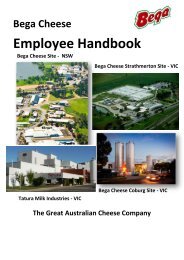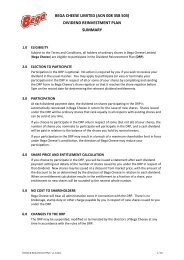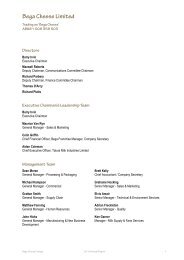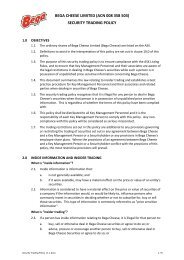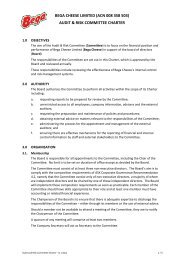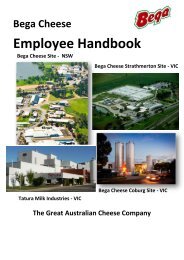Presentation - Bega Cheese
Presentation - Bega Cheese
Presentation - Bega Cheese
- No tags were found...
Create successful ePaper yourself
Turn your PDF publications into a flip-book with our unique Google optimized e-Paper software.
<strong>Bega</strong> <strong>Cheese</strong> Limited<br />
Octa Phillip<br />
Agribusiness Conference<br />
Barry Irvin AM<br />
Executive Chairman<br />
Co-Manager
Building a Bridge to a Sustainable Future<br />
<strong>Bega</strong> <strong>Cheese</strong> Limited
If you want a receipt, you’ll<br />
have to wait until I close. I’m<br />
right handed.<br />
Markets
Australian dairy – a brief history<br />
2000 Complete deregulation and<br />
implementation of DSAP<br />
1983 CER agreement with NZ<br />
1986 Kerin Plan implemented<br />
1997-1999 The states review<br />
drinking milk regulations<br />
1996 DMS Scheme implemented<br />
with sunset date of June 2000<br />
<strong>Bega</strong> <strong>Cheese</strong> Limited
Australian industry market mix<br />
12,000<br />
10,000<br />
8,000<br />
6,000<br />
4,000<br />
2,000<br />
0<br />
Domestic Export Share exported (right axis)<br />
90/91 92/93 94/95 96/97 98/99 00/01 02/03 04/05 06/07 08/09 10/11<br />
(e)<br />
60%<br />
50%<br />
40%<br />
30%<br />
20%<br />
10%<br />
0%<br />
5
Comparison of producers/exporters<br />
EU 27 New Zealand Australia US Brazil<br />
Population* 503 mill 4 mill 22 mill 309 mill 195 mill<br />
GDP –<br />
economy<br />
size*<br />
Milk<br />
production<br />
Share<br />
exported<br />
Share of<br />
trade<br />
17,960 bill 131 bill 916 bill 14,582 bill 2,172 bill<br />
148 bill l 17 bill l 9.3 bill l 86 bill l 28 bill l<br />
11% 94% 43% 6% 3%<br />
34% 34% 8% 11% 2%<br />
*2010 figures Sources: CIA World Factbook, OECD, World Bank, ZMP
Drivers of the global market<br />
• Demand<br />
– Retail, foodservice and industrial<br />
– Internal demand vs export availability<br />
– Economic activity and disposable incomes<br />
– Substitute fat & protein prices<br />
• Supply<br />
– Milk production and product mix<br />
– Inventory levels (commercial and Government)<br />
– Feed grain prices (US)<br />
• Dairy Policy<br />
– Market support<br />
– Market access<br />
– Other government intervention<br />
• Wildcards<br />
– Weather<br />
– Exchange rates
Food weighting in CPI<br />
Price sensitivity in<br />
developing markets
Long range global scenario<br />
Driven by the<br />
developing world<br />
9
• Ingredients<br />
• Retailers<br />
Defining the Market –<br />
Australian Perspective<br />
– Branded consumer products<br />
– Private label<br />
– Convenience stores<br />
• Out of home dining<br />
– Quick service restaurants<br />
– Hotels, restaurants, catering
Defining the Market –<br />
Australian Perspective<br />
<strong>Bega</strong> <strong>Cheese</strong> Limited
Product Range and Infrastructure<br />
• Cheddar & Processed <strong>Cheese</strong><br />
• Mozzarella<br />
• Cream <strong>Cheese</strong><br />
• Nutritional Powders<br />
• Nutraceuticals<br />
• Milk Powders<br />
• Whey Powders
Product Range<br />
Nutritionals
Dairy Nutritionals<br />
Market Dynamics and Evolution<br />
World Market for Infant Formula (2009)<br />
SE Asia 25%<br />
The world market for infant<br />
formula is dominated by Asia<br />
with about 53% of volume.<br />
India 7%<br />
China 24%<br />
Japan<br />
4%<br />
Source: The CIA World Fact Book, Euromonitor
Market Dynamics<br />
The major forces driving category growth relate to the increasing recognition of the<br />
importance of nutrition, increasing purchasing power of women, growing middle<br />
class and longer life spans.<br />
Increasing<br />
Middle Class<br />
&<br />
Births<br />
Increasing<br />
Purchasing<br />
Power of<br />
Women<br />
Increasing<br />
Importance<br />
of Nutrition<br />
25%<br />
Longer Life Span<br />
&<br />
Ageing<br />
Population<br />
26%<br />
Source: Mead Johnson 2010 Investor Report<br />
Source: Baby food U&A study 2007 , (2) IM U&A Online Survey, Dec 2008 Heinz Study
Market Dynamics<br />
Consumption of Milk Formula by volume (2010)<br />
Consumption<br />
(g/infant/day)<br />
Thailand<br />
Malaysia<br />
France<br />
Germany<br />
USA<br />
The wealth of nations<br />
(measured by GDP per<br />
capita) is also a strong<br />
driver of consumption<br />
of nutritional products.<br />
Vietnam<br />
Indonesia<br />
Mexico<br />
Philippines<br />
China<br />
Average World Consumption = 31 g/infant/day<br />
GDP per Capita ($US)<br />
Source: The CIA World Fact Book, Euromonitor, My Decker Capital (“Infant Formula Industry in China”, Dec. 2010)<br />
Note: Bubble area proportional to population
Market Dynamics<br />
Asia Demand for Life-Stage Dairy Nutritionals<br />
Growth (% pa 2005 – 2010) Value ($US ‘00 M – 2010)<br />
The value of Life-Stage Dairy<br />
Nutritionals within Asia is<br />
estimated at $US14B and<br />
has grown at about 15%<br />
over the 2005 to 2010<br />
period.<br />
Source: Euromonitor
Australian & International<br />
Market Profile<br />
Australian Market<br />
• Major supermarkets<br />
Food Service<br />
• Ingredients<br />
International Market<br />
• North Asia<br />
• Japan<br />
• Korea<br />
• Asia<br />
• Middle East
Australian Market Trends<br />
Grocery $ Performance by Type | MAT to 02/10/11<br />
• From a historic perspective, there is a strong inverse relationship between value<br />
growth between Cafes, Restaurants and Takeaways and private Label Food<br />
• Stable economic times see PL performance decline<br />
• The latest 3 qtrs show PL starting to strengthen<br />
<strong>Bega</strong> <strong>Cheese</strong> Limited
Market Trends<br />
Grocery $ Performance by Type | MAT to 02/10/11<br />
• As consumer Confidence drops Total Food increases, P/L seeing a significantly greater boost than<br />
Branded<br />
• Consumers discretionary spend will shift from Cafes & Restaurants into Grocery Food retailing<br />
<strong>Bega</strong> <strong>Cheese</strong> Limited
Retail – Private Label
<strong>Bega</strong> <strong>Cheese</strong> Limited<br />
Retail – Private Label: Dairy
Retail - Brands<br />
Brand Investment<br />
• Quality<br />
• Delivery on brand promise<br />
• Customer experience<br />
• New product development<br />
• Value<br />
• Providence<br />
<strong>Bega</strong> <strong>Cheese</strong> Limited
Defining the Markets<br />
Customer Investment<br />
• International customers<br />
• Business to business customers<br />
• Retailers<br />
• Quick service restaurants<br />
• Consumers<br />
Quality<br />
Delivery on brand promise<br />
Customer experience<br />
New product development<br />
Value<br />
Providence<br />
<strong>Bega</strong> <strong>Cheese</strong> Limited
Leadership<br />
• Trade<br />
• Infrastructure<br />
• Research & Development<br />
• Working environment<br />
• Market investment<br />
• Staying the course<br />
<strong>Bega</strong> <strong>Cheese</strong> Limited
Significant Investment in Infrastructure<br />
• Five plants with well developed technologies<br />
including robotics and automated processing<br />
lines<br />
• Continual investment in technologies to ensure a<br />
high level of production efficiency is maintained<br />
• Unutilised manufacturing capacity at plants<br />
allows for efficient increases in levels of<br />
production<br />
• Strong commitment to environmental<br />
management and sustainability<br />
Map of Facilities<br />
<strong>Bega</strong><br />
Tatura<br />
Strathmerton<br />
Coburg<br />
<strong>Bega</strong> <strong>Cheese</strong> Limited
Diversified Earnings Across Businesses<br />
Overview from the receipt of milk and other raw material and the processing by the <strong>Bega</strong> <strong>Cheese</strong><br />
Note: The size of boxes and arrows in the above chart does not reflect the relative size of each business
High quality business model with diversified<br />
earnings across businesses and geographies<br />
• Diversified earnings across both the manufacturing and the cutting, packaging and processing of dairy products<br />
• Diversified earnings across a wide variety of dairy products<br />
• Earnings spread across geographic regions with a growing global market presence<br />
• Strong relationships with major FMCG customers whose long term contracts operate on a cost-plus margin basis<br />
• On-going royalty income from Australian trade mark licence of the <strong>Bega</strong> brand<br />
<strong>Bega</strong> <strong>Cheese</strong> Group FY2011F<br />
Revenue by Destination<br />
<strong>Bega</strong> <strong>Cheese</strong> Group FY2011F<br />
Revenue by Business Unit
Group Sales & Assets<br />
Sales<br />
Consolidated Assets<br />
1,000,000<br />
900,000<br />
800,000<br />
700,000<br />
600,000<br />
500,000<br />
400,000<br />
300,000<br />
200,000<br />
100,000<br />
0<br />
500,000<br />
450,000<br />
400,000<br />
350,000<br />
300,000<br />
250,000<br />
200,000<br />
150,000<br />
100,000<br />
50,000<br />
0<br />
<strong>Bega</strong> <strong>Cheese</strong> Limited
1H 2012 Results highlights*<br />
• EBITDA increase 12.3% to $32.8m<br />
• PBT increase 31% to $18.6m<br />
• EPS down 3.6% - new share capital issued 16%<br />
• Interim dividend of 3.0 cents per share fully franked<br />
• Milk intake increase 16% to 411m litres<br />
• Increase in total production of 7% to 104,000t<br />
• Capital expenditure $12.2m<br />
*Comparison to prior corresponding period<br />
<strong>Bega</strong> <strong>Cheese</strong> Limited
Down on the Farm<br />
• 100 dairy farms in NSW<br />
• 400 dairy farms in Victoria
South Australia 7% Qld 7%<br />
Western Australia 4%<br />
NSW 8%<br />
Victoria 64%<br />
Tasmania 7%<br />
<strong>Bega</strong> <strong>Cheese</strong> Limited
Australian Milk Production Trends<br />
12,000<br />
M. litres<br />
Share Exported<br />
70%<br />
10,000<br />
60%<br />
8,000<br />
6,000<br />
4,000<br />
2,000<br />
Exports<br />
Australia<br />
50%<br />
40%<br />
30%<br />
20%<br />
10%<br />
0<br />
0%<br />
Australia exports approx. 45% of milk production - total value in 2009/10 of $A 2.4 billion
Long term trends<br />
1980 1990 2000 2011<br />
Farms 21,994 15,396 12,896 6,883<br />
Milk produced<br />
(mill litres)<br />
5,432 6,262 10,847 9,101<br />
Cows (‘000) 1,880 1,654 2,171 1,600<br />
Av herd size 85 107 168 232<br />
Share of milk<br />
exported<br />
22% 31% 54% 45%
Making our own way!<br />
BEMS<br />
Purpose: To secure milk supply by helping our suppliers<br />
to improve management practices associated with<br />
sustainability issues, both real and perceived, identified<br />
by our customers, the dairy industry and the community<br />
as being important.<br />
Key assumption: By encouraging our farmers to adopt<br />
industry acceptable management practices our farmers<br />
are most likely to be minimising their impact on the<br />
natural environment and operating in a sustainable<br />
manner.
BEMS Sustainability Assessment<br />
BEMS Sustainability Issues<br />
Soil Management<br />
Nutrient Management<br />
Effluent Management<br />
Irrigation Management<br />
Greenhouse gas emissions<br />
Biodiversity & Waterways<br />
Energy & Water in the dairy<br />
Pest & Weeds<br />
Chemical use management<br />
Farm Wastes<br />
People management<br />
Exceptional Circumstances & OH&S<br />
Animal Health<br />
Animal welfare
BEMS Priority Areas for Improvement<br />
The priority NRM sustainability issues identified in the original BEMS Pilot were;<br />
Effluent<br />
MGT<br />
Irrigation<br />
MGT<br />
Nutrient<br />
MGT<br />
Native Veg<br />
&<br />
Waterways<br />
Soil MGT<br />
GHG’s<br />
Water &<br />
Energy<br />
Chemicals Wastes Pests
BEMS Sustainability Assessment<br />
Initial results from 17 farms across 2 supplier regions
BEMS Achievements<br />
to date<br />
• 42 effluent systems upgraded enabling the reuse of 160ML<br />
water 12,000 tonnes of effluent to be reused over 280ha<br />
of dairy pasture.<br />
• 20 stream crossing, 28 laneway upgrades and 37 erosion<br />
sites remediated preventing 300 tonnes of effluent and<br />
140 tonnes of sediment entering waterways<br />
• Soil tests & nutrient maps produced for 84 farms<br />
(15,000ha)
BEMS Achievements to date<br />
• 127km of fencing, 145ha of revegetation protecting &<br />
enhancing 98km of river frontage, 184ha of wetlands and<br />
23ha of terrestrial vegetation<br />
• 38 dairy shed energy audits completed, 12 farms<br />
completed energy efficiency upgrades saving $27,133 and<br />
110 tonnes Co2 emissions per year
<strong>Bega</strong> <strong>Cheese</strong> Limited<br />
Australian Agriculture
Thank you



